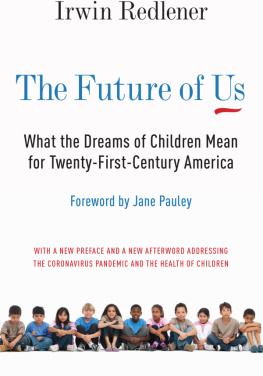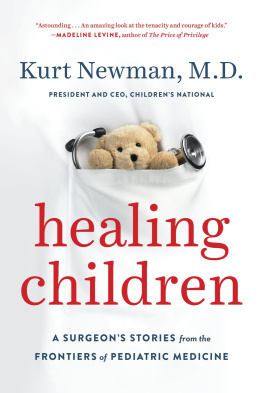Irwin Redlener - The Future of Us: What the Dreams of Children Mean for Twenty-First-Century America
Here you can read online Irwin Redlener - The Future of Us: What the Dreams of Children Mean for Twenty-First-Century America full text of the book (entire story) in english for free. Download pdf and epub, get meaning, cover and reviews about this ebook. year: 2017, publisher: Columbia University Press, genre: Home and family. Description of the work, (preface) as well as reviews are available. Best literature library LitArk.com created for fans of good reading and offers a wide selection of genres:
Romance novel
Science fiction
Adventure
Detective
Science
History
Home and family
Prose
Art
Politics
Computer
Non-fiction
Religion
Business
Children
Humor
Choose a favorite category and find really read worthwhile books. Enjoy immersion in the world of imagination, feel the emotions of the characters or learn something new for yourself, make an fascinating discovery.
- Book:The Future of Us: What the Dreams of Children Mean for Twenty-First-Century America
- Author:
- Publisher:Columbia University Press
- Genre:
- Year:2017
- Rating:4 / 5
- Favourites:Add to favourites
- Your mark:
The Future of Us: What the Dreams of Children Mean for Twenty-First-Century America: summary, description and annotation
We offer to read an annotation, description, summary or preface (depends on what the author of the book "The Future of Us: What the Dreams of Children Mean for Twenty-First-Century America" wrote himself). If you haven't found the necessary information about the book — write in the comments, we will try to find it.
Raymond is a talented young artist who carries his work from homeless shelter to homeless shelter in a tattered bag but has never even been inside a museum. He is emblematic of the children that the renowned pediatrician and childrens advocate Irwin Redlener has met over the course of his long and colorful career. Inadequate education, barriers to health care, and crushing poverty make it overwhelmingly difficult for many children to realize their dreams. In this memoir, Redlener draws on poignant personal experiences to investigate the nations healthcare safety net and special programs that are designed to protect and nurture our most vulnerable kids, but that too often fail to do so.
The book follows Redleners winding career, from his work as a pediatrician in the Arkansas delta, to treating child abuse in a Miami hospital, to helping children in the aftermath of 9/11 and Hurricane Katrina. The reader accompanies him to the board of USA for Africa, to cofounding the Childrens Health Fund with Paul Simon, as he persuades Joan Baez to play a benefit concert for his clinic in rural Arkansas, and to dinner with Fidel Castro. But what has motivated him most powerfully are the children who struggle with terrible adversities yet dream of becoming paleontologists, artists, and marine biologists. These stories are his springboard for discussing larger policy issues that hinder us from effectively eradicating childhood poverty and overcoming barriers to accessible health care. Persistent deprivation and the avoidable problems that accompany poverty ensnare millions of children, with rippling effects that harm the health, prosperity, and creativity of the adults they become. Redlener argues that we must drastically change our approach to meeting the needs of childrenfor their sake and to ensure Americas resiliency and influence in an increasingly complex and challenging world.
Irwin Redlener: author's other books
Who wrote The Future of Us: What the Dreams of Children Mean for Twenty-First-Century America? Find out the surname, the name of the author of the book and a list of all author's works by series.








